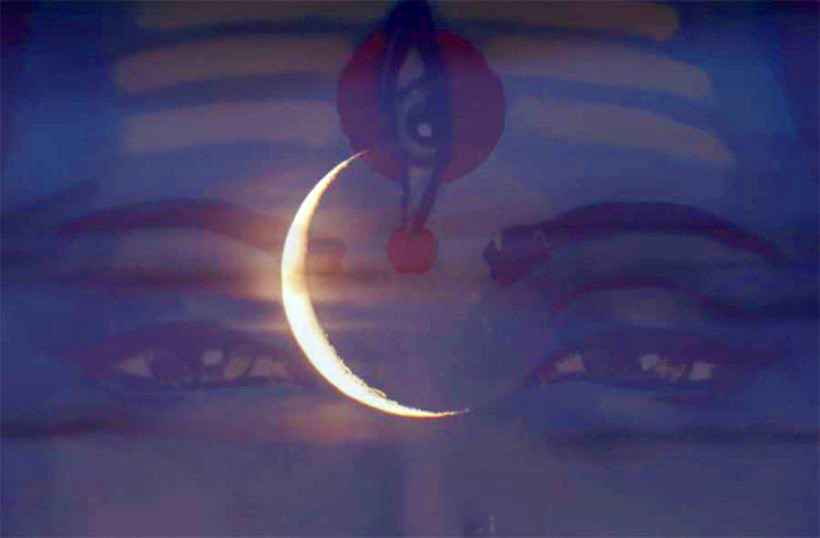
by Somya Devi | Mar 11, 2021 | Astrology, Conjunctions, Holy Days
New Moon and Maha Shivaratri, March 2021
The Sun and Moon join near the end of sidereal Aquarius on the dark night of March 12th, with an exact alignment under the New Moon at 5:21 am ET on Saturday, March 13th. Mercury and Venus also join the Moon and Sun in Aquarius, while Saturn (with Jupiter in sidereal Capricorn) once again rules over 6 grahas at the time of the New Moon. Mars and Rahu continue their conjunction in sidereal Taurus, opposite Ketu in Sagittarius, forming a Kala Sarpa Yoga in the sky. Thursday night, the fourteenth night of the waning Moon, marks the Maha Shivaratri celebration this month. Sun and Moon begin this cycle in the Vedic nakshatra Purva Bhadrapada, an auspicious sign for spiritual advancement.
Aquarius Cycle
With the new lunar cycle beginning in Aquarius, the coming month may have a quirky and forward-thinking tone, and we may see some scientific advances this month. The Mars Rover landing actually occurred just days after the Sun had entered its Aquarius cycle. Aquarius is in fact very much about service to the greater good. With Saturn strong in his own sign, we could see many significant advances in social support structures right now.
Aquarius is known as Kumbha in Sanskrit, a word for “pitcher” or “vessel.” According to the Vedic texts, the sign Kumbha can be imagined as a man holding a pot, with deep-brown skin, standing in the water. We can see this Aquarian imagery in the sadhus of India (and its biggest ritual pilgrimage day, the Kumbha Mela), who make their lives an offering of service to society through their prayers and Saturnian austerities, while renouncing the individual self. In the Aquarius cycle, we think about how we can serve the whole.
Maha Shivaratri
Thursday night, March 11th in North America, the night prior to the Dark Moon night, is the fourteenth waning phase of the lunar cycle. During this month this night is celebrated as Maha Shivaratri. This is the most auspicious night of the year for doing sadhana (spiritual practice). It is traditional on this night to stay up all night fasting, chanting, praying, and meditating. This holiday honors Lord Shiva, the great ascetic, as we recall two stories of great sacrifices that he made protect the entire creation.
One of these is the story of the gods and demons churning of the milk ocean in order to release the nectar of immortality. Before the nectar came up, however, a poison came up first. (This is similar to when we do spiritual practice and begin our path of self-inquiry, and negative tendencies often come to light first, which can be a painful experience. Similarly, during a physical fast or cleanse, toxins can be shaken loose and released first, causing a healing crisis before we continue healing into a freer, happier state of being.) When the poison came up from the milk ocean, Lord Shiva consumed it so that it would not engulf humanity, as a great and noble sacrifice. His wife, Parvati, however, held his throat so that he could not ingest it, thus saving him from being harmed by the poison.
Maha Shivaratri also commemorates the wedding of Shiva and Parvati, which also stemmed from great sacrifice made for the benefit of all humanity. It was said that after his first wife, Sati, perished, Shiva was fully devoted only to his sadhana, meditating for aeons in isolation and renouncing the world. Then the demon Tarakasura began running amock on earth, threatening all of humanity. Brahma foretold that only Shiva’s child could defeat Tarakasura, so the gods devised a plan for Sati to reincarnate as Parvati, and win over her Lord to marriage once again to produce this heir. Shiva was not easily swayed, however, and it was only after Parvati became an ascetic and underwent great penance that he agreed to marry. They eventually produced their son Kartikkeya, who went on to slay the demon.
Thus, this holiday is celebrated through the penance of fasting, forgoing food, water, and sleep, for one night, and simultaneously celebrating the union of Lord Shiva and Parvati, or the masculine and feminine energies of creation, that allows the dance of life to continue. It is an apt time to feel the forces of Aquarius upon us, which compel us to consider our role in society, and in the universe, and what personal sacrifices we can make for the greater good. Even if you’re not able to stay up the whole night, any amount of devotional practice, serviceful sacrifice, or chanting of Om Namah Shivaya on this night can have beneficial affects that are magnified greater than on any other night.
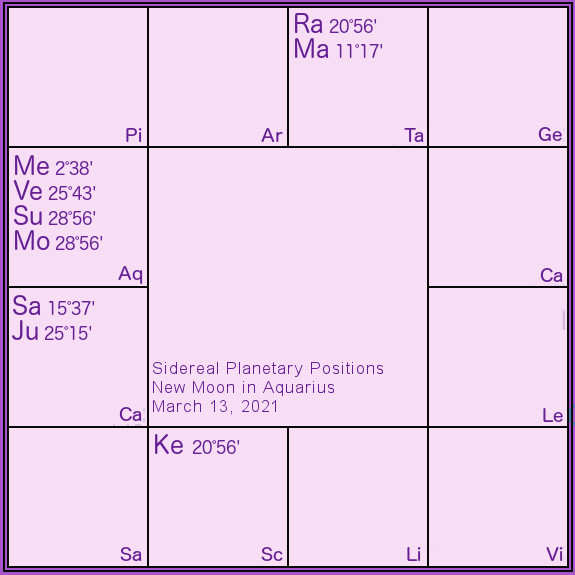
Kala Sarpa Yoga
This year’s Kala Sarpa yoga cycles continue, as Rahu and Ketu appear to cut the sky in half with all planets to one side of the nodal axis. Kala Sarpa can be translated as “black snake” or the “serpent of time,” and intensifies subtle forces on all levels, including inner challenges as well as strengths and yogic combinations in a chart. Mars joins Rahu in Taurus, and tho he will transit out of Taurus and into Gemini in one month, technically breaking the cycle, the intensity brought on by the alignment can sometimes continue when only one planet has crossed to the other side of the sky.
Purva Bhadrapada
The former “lucky-footed one” is the Vedic nakshatra (star-sign) where Sun and Moon begin this lunar cycle. This nakshatra bridges Aquarius and Pisces and is often represented by a funeral cot, symbolizing the transition from life into death, or ultimate liberation. It is ruled by Aja Epakada, the one-footed goat who is often associated with the image of Lord Shiva as Nataraj dancing on one foot, a fitting image for Maha Shivaratri.
Om Namah Shivaya!
Personal Chart Readings with Coaching Are Available Here

by Somya Devi | Feb 28, 2019 | Astrology, Conjunctions, Holy Days, Planets Changing Signs, Retrograde
The Moon wanes in sidereal Aquarius on the dark night of March 5th, approaching the exact Sun-Moon alignment for a New Moon at 8:04 am on Wednesday, March 6th, beginning a new lunar cycle. Leading up to this will be Maha Shivaratri, “the great night of Lord Shiva,” on March 4th. This is an auspicious night for prayer and penance, and the benefits of sadhana are multiplied by the Moon’s position and the collective vibration.
Maha Shivaratri
Monday night, March 4th, the night prior to the Dark Moon night, is the fourteenth waning phase of the lunar cycle. During this month this night is celebrated as Maha Shivaratri. This is perhaps the most auspicious night of the year for doing sadhana (spiritual practice). It is traditional on this night to stay up all night fasting, chanting, praying, and meditating. This holiday honors Lord Shiva, the great ascetic, and we can recall two stories of great sacrifices that he made protect the entire creation.
One of these is the story of the churning of the milk ocean, which the gods and demons were doing in order to release the nectar of immortality. Before the nectar came up, however, a poison came up first. (This is similar to when we do spiritual practice and begin our path of self-inquiry, and negative tendencies often come to light first, which can be a painful experience. Similarly, during a physical fast or cleanse, toxins can be shaken loose and released first, causing a healing crisis before we continue healing into a freer, happier state of being.) When the poison came up from the milk ocean, Lord Shiva consumed it so that it would not engulf humanity, as a great and noble sacrifice. His wife, Parvati, however, held his throat so that he could not ingest it, thus saving him from being harmed by the poison.
Maha Shivaratri also commemorates the wedding of Shiva and Parvati, which also stemmed from great sacrifice made for the benefit of all humanity. It was said that after his first wife, Sati, perished, Shiva was fully devoted only to his sadhana, meditating for aeons in isolation and renouncing the world. Then the demon Tarakasura began running amock on earth, threatening all of humanity. Brahma foretold that only Shiva’s child could defeat Tarakasura, so the gods devised a plan for Sati to reincarnate as Parvati, and win over her Lord to marriage once again. He was not easily swayed, however, and it was only after Parvati became an ascetic and underwent great penance that he agreed to marry. They eventually produced their son Kartikkeya, who went on to slay the demon.
Thus, this holiday is celebrated through the penance of fasting, forgoing food, water, and sleep, for one night, and simultaneously celebrating the union of Lord Shiva and Parvati, or the masculine and feminine energies of creation, that allows this dance of life to continue. It is an apt time to feel the forces of Aquarius upon us, which compel us to consider our role in society, and in the universe, and what personal sacrifices we can make for the greater good. Even if you’re not able to stay up the whole night, any amount of devotional practice, serviceful sacrifice, or chanting of Om Namah Shivaya on this night can have beneficial affects that are magnified greater than on any other night.
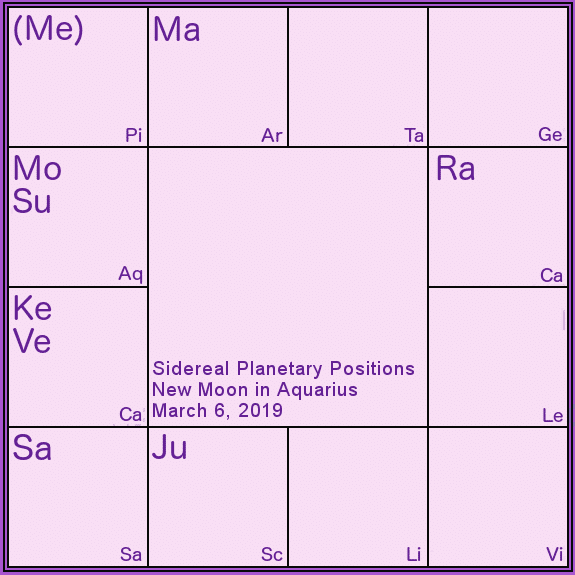
Aquarius Moon Cycle
The Sun and Moon meet in sidereal Aquarius to begin this lunar cycle. Aquarius is known as Kumbha in Sanskrit, a word for “pitcher” or “vessel.” According to the Vedic texts, the sign Kumbha can be imagined as a man holding a pot, with deep-brown skin, standing in the water. We can see this Aquarian imagery in the sadhus of India (and its biggest ritual pilgrimage day, the Kumbha Mela), who make their lives an offering of service to society through their prayers and Saturnian austerities, while renouncing the individual self. In the Aquarius cycle, we think about how we can serve the whole.
Saturn both rules Aquarius and is aspecting the Sun and Moon here (from sidereal Sagittarius) at the time of this New Moon. Saturn brings to us awareness of the long term and the bigger picture, and through this masculine or active sign, compels us to make commitments and offerings to something greater than ourselves and our momentary happiness. This is a great month to consider a new way that you may be of service to your community or to society.
Purva Bhadrapada
The New Moon cycle begins with the Sun and Moon in the Vedic nakshatra called Purva Bhadrapada, the former “lucky footed one.” This nakshatra bridges Aquarius and Pisces and is often represented by a funeral cot, symbolizing the transition from life into death, or ultimate liberation. It is ruled by Aja Epakada, the one-footed goat who is often associated with the image of Lord Shiva as Nataraj dancing on one foot, a fitting image for Maha Shivaratri.
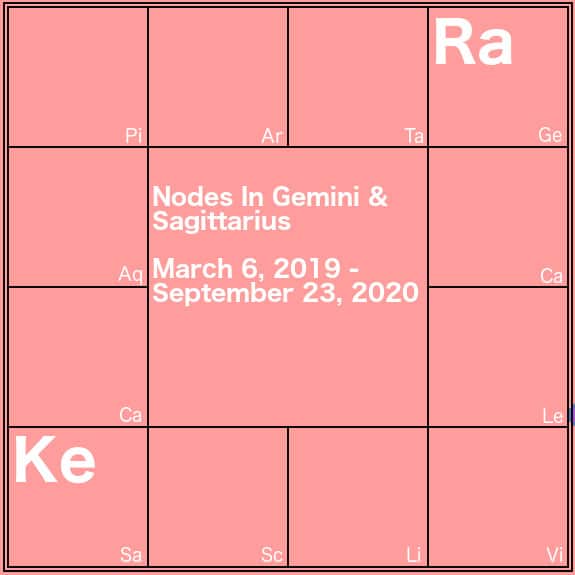 Nodes Are Changing Signs!
Nodes Are Changing Signs!
With a mean node calculation, Rahu and Ketu will transit into Gemini-Sagittarius on March 6th. (Under a true node calculation, they will not change signs until March 23rd; See Technicalities: Mean vs. True Node section below if you want a little more info about nodal calculations.) Regardless of the calculation used, March is a month of transition for the nodal energy. With the nodes in Cancer-Capricorn for the last year-and-a-half, we collectively felt a dichotomy between listening to the heart and following our emotions, against doing what is practical and responsible in an earthly way. It was a chance to balance these two things as well, learning to create a harmony between the practical and the emotional.
Throughout the coming transit of Rahu and Ketu through Gemini and Sagittarius, we will be feeling a polarization between curiosity, fact-finding and learning in an intellectual way, versus taking actions based on our principles and beliefs. Sometimes the intellectual mind does not agree with our fiery passions. This transit will be a time to learn to balance the two. With opinionated Sagittarius on one side, and communicative yet flexible Gemini on the other side, we may learn new ways to communicate and interact with those who oppose us in ideas, stepping into another’s shoes while still maintaining and honoring our personal beliefs and philosophy.
For each natal rising sign, this coming transit will affect a particular axis of learning in your life. You will be more able to see and work with some of your blind spots in these areas throughout the coming year-and-a-half long nodal transit. These things will especially surface around the bi-annual pairs of eclipses (coming this year in July and December).
Mercury Retrograde
Mercury stations and begins apparent retrograde motion on March 5th, the day before the New Moon. He is also currently debilitated in sidereal Pisces, so this time period could have us a bit mixed up around some details, and possibly challenged with communication and accuracy. He’ll retrograde back into Aquarius on March 14th, before returning to direct motion on the 28th.
Jupiter Gandanta
Also during the first half of this lunar cycle, Jupiter will enter the last 48 minutes of sidereal Scorpio (one muhurta), on March 15th. This region of the sky, called gandanta or a “knot,” is considered one of the most difficult places in the zodiac. It spans for one muhurta before and after the 0° point between sidereal Scorpio and Sagittarius, as well as those regions on the cusp of Cancer-Leo and Pisces-Aries (however, this gandanta location is often considered the most difficult. (Some astrologers may consider it spanning up to one or even two or three degrees to either side of the cusps.)
Normally, a planet transits through this zone rather quickly. Jupiter is currently slowing down, however, and will come to a stationary halt at 0°14’ of sidereal Sagittarius on April 10th, before beginning retrograde motion and passing back into Scorpio. He will threrefore be traveling the gandanta zone all the way from March 15th until May 6th (or longer if the zone is interpreted as wider).
Though Jupiter will be dipping into his own sign from March 15th through April 22nd, the fact that he will remain in gandanta at this time will not bring the added strength that we would expect from a sva graha. Those who are ruled by Jupiter may feel a bit “stuck” in various ways throughout this transit. It is important to be patient and keep up with sadhana during this time. Additionally, he will be joined by both Saturn and Ketu during his time in Sagittarius, both of which can be challenging companions.
Technicalities: Mean vs. True Node
Rahu and Ketu have been transiting through the Cancer-Capricorn axis for nearly 18 months, and are getting ready to make their transition into the Gemini-Sagittarius axis, for the next 18. The date of this transition will vary whether you are using the “mean node” calculation or the “true node” calculation. To simplify this as much as possible, we must realize that the nodes do not have planetary bodies that can be observed as the other grahas can be. (The grahas are “the forces that grab us,” including the Sun, Moon, Mars, Mercury, Jupiter, Venus, Saturn, Rahu and Ketu.)
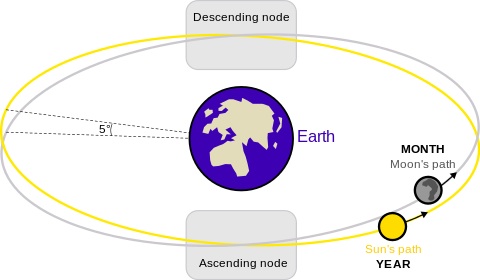 The nodes, astronomically are the places where the Sun’s and Moon’s paths intersect. The ecliptic is the apparent paths that the Sun travels “around” the Earth. The Moon’s orbits is not completely flat or parallel with the Sun’s, but slightly inclined, so that it passes this line and is sometimes to the north of it, sometimes to the south. We can measure astronomically and by observation when these crossings happen. To get the mean node, we take an average distance between these two points based on how many days it takes the Moon to get from one to the other. The true node is calculated using a method that also accounts for the slight wobble of the earth and the Moon’s orbit around it.
The nodes, astronomically are the places where the Sun’s and Moon’s paths intersect. The ecliptic is the apparent paths that the Sun travels “around” the Earth. The Moon’s orbits is not completely flat or parallel with the Sun’s, but slightly inclined, so that it passes this line and is sometimes to the north of it, sometimes to the south. We can measure astronomically and by observation when these crossings happen. To get the mean node, we take an average distance between these two points based on how many days it takes the Moon to get from one to the other. The true node is calculated using a method that also accounts for the slight wobble of the earth and the Moon’s orbit around it.
Some astrologers favor using the “mean” node calculation while others prefer the “true.” These two calculations of the node will sometimes put them about one degree apart, which is noticeable in cases where, in a natal chart, someone’s node is on the cusp of two signs (it may be in one sign using mean node and another sign using true node). It also affects the date of transition between signs that we observe when talking about nodal transits. In both cases, it is best to observe for yourself (use a lot of charts for case studies) and see which makes the most sense to you. I prefer using mean node calculation.
Personal Readings are available to help you understand your individual natal chart and how these transits will affect your upcoming year.

by Somya Devi | Dec 19, 2018 | Astrology, Conjunctions, Events, Retrograde
This coming full Moon night also falls on the longest night of the year in the northern hemisphere, the winter solstice! The solstice, December 21st, is the day when the Sun is at its farthest course south of the equator, making for the longest day in the southern hemisphere and the longest night in the northern. The Moon will be bright and waxing in its fullest Moon phase, purnima tithi, on this night, approaching maximum fullness in sidereal Gemini at 9:49 am PST on Saturday, December 22nd. Moon lovers, take this chance to enjoy the most moonlight you can get in one night, until this coincidence next occurs in 2094!
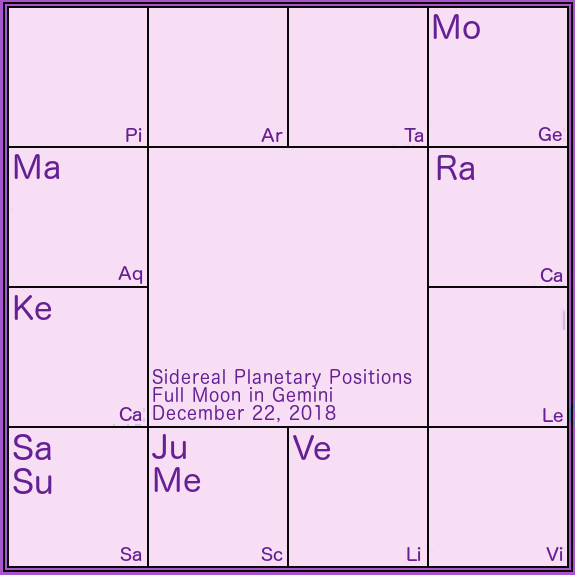
Full Moon in Gemini
The full Moon will reach maximum illumination at 6° sidereal Gemini, opposite the Sun at 6° sidereal Sagittarius. Also in Ardra nakshatra, this Full Moon is aligned with the outer reaches of our galaxy, stretching towards far distant space. This energy is appropriate for the winter solstice, which is a deeply yin time of year as we become more still in the lengthy hours of darkness, allowing more space in our beings, and in between our bouts of activity.
Ardra
Ardra, also Arudra, is a turbulent place, however, ruled by Lord Shiva in the form of Rudra, the fierce bringer of storms. Though there is a certain energy of renewal here, it is the type of renewal that comes after difficult or destructive situations. The full Moon here can help us to truly let go of some of the things from the past year that we no longer need, but for some it could be a chaotic-feeling process.
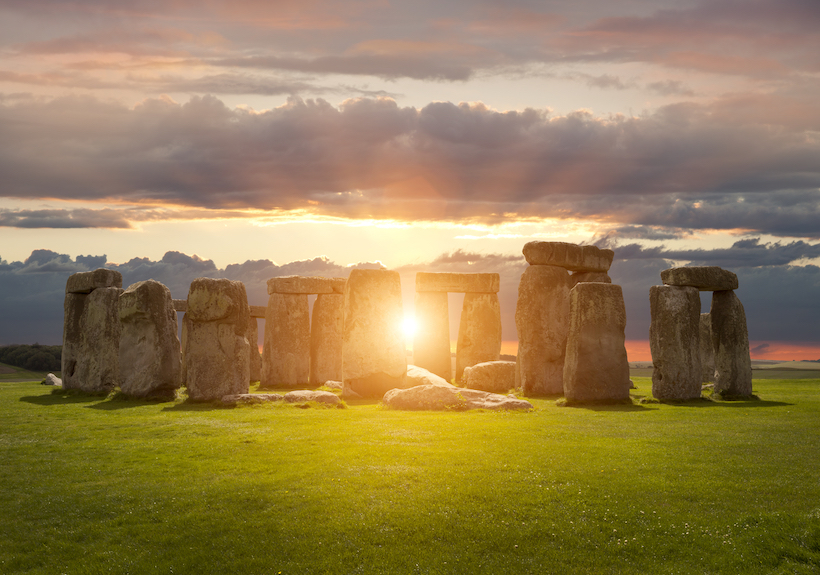 Solstice
Solstice
The winter solstice is when the Sun is farthest from its northern course, allowing the night hours to exceed the day, the further you go north. It is also a turning point in the cycle of light, and after this point in time the light will slowly begin to return and the days lengthen. The solstice and the days surrounding are like a still point, however, like the powerful moment between exhalation and inhalation. Consider incorporating an awareness of this moment in the breath cycle into your meditation practice during this time of year.
It is somewhat paradoxical that we will experience the solstice and the full Moon together, as the winter solstice is a time to be very inward, and full Moon energy usually draws us out into a more extroverted state. Gemini is a dual sign that helps us to look at both sides of life, however, so it is also appropriate. With all things, there is a lesson coming forth to teach us about balance, and how to balance these energies, nourishing our inward nature while likely participating in some kind of gatherings or celebrations that draw our energy outward.
From the 22nd through the end of the year will be a waning phase for the Moon, and during this lunar cycle in particular, it is a potent time to allow yourself to let go of all the baggage from the past year, allowing it to compost and creating fertile ground for the next year to come (just as Shiva, the cosmic composter, brings this energy through the stormy rains).
Though the holidays are a time to celebrate, it’s important to be careful right now of overexerting your yang or active energy, and to recognize the real gift of cultivating yin during these dark months. It is a time to create more inward space for your body, mind and spirit. The dormant season of winter is a time to nourish and rejuvenate, and it’s important not to let these celebrations become depleting.
Jupiter-Mercury War
Jupiter and Mercury will be engaged in a planetary war (graha yuddha) from midday on December 20th through early morning on the 22nd. During this time the two planets will be traveling within one degree of each other, in sidereal Scorpio. This can bring up an internal conflict between what we strongly believe (philosophically, spiritually, or politically), and what makes sense in a practical, earthly way. This war can also create a paradox between two or more areas of your life, those ruled by Jupiter and Mercury in your individual natal chart. Check out your chart and pay attention to the interaction of what these planets rule for you over the next few days.
Venus
Venus is nearing the end of his four-month transit through sidereal Libra. Strong and powerful in his own sign, the ideals of beauty, pleasure and harmony have been forefront for many of us over the last few months. This transit began on August 31st, and Venus then appeared to slow to a halt and then travel in retrograde motion through Libra from October 5th through November 15th. This retrograde stint gave us a chance to really closely examine our relationships, as well as our approaches to happiness in general.
As we move forward through these last weeks of Venus in Libra, we should be integrating some of the lessons we have learned through this transit. What have the past few months taught you, and how can you proceed with more wholeness? What are your methods for seeking pleasure, and are these working for you? If not, what needs to change? When you get what you think you want, are you truly happy?
 Venus is the planet that reminds us that we aren’t usually truly happy if our pleasure comes at the expense of someone else’s whom we care about. How are you at compromising in your relationship? Is it too little, or too much, costing one of you (and thus both) the happiness you deserve? What kind of boundaries do you have with others in general, and are those working for you (or them)?
Venus is the planet that reminds us that we aren’t usually truly happy if our pleasure comes at the expense of someone else’s whom we care about. How are you at compromising in your relationship? Is it too little, or too much, costing one of you (and thus both) the happiness you deserve? What kind of boundaries do you have with others in general, and are those working for you (or them)?
This transit may also have gotten you in touch with the way you handle sensual indulgences, be it food, drink, shopping, sex, or intoxicants. The drive may have been turned on high during this period, with a chance to slow down and scrutinize your methods during the weeks of Venus Retrograde. Moving into the new year, as Venus transits into sidereal Scorpio on January 1st, take the opportunity to harvest and integrate the lessons you have learned about yourself, and your own Venusian nature.
2019
As we come into the New Year I will be adding more updates on what to expect, as well as co-hosting a Webinar on 2019 Transits with a number of my Jyotish colleagues. Be sure to tune into the webinar, stay on the free mailing list, and consider getting an individual reading to see how the coming year’s transits will affect you personally.
Many blessings and Happy Solstice!
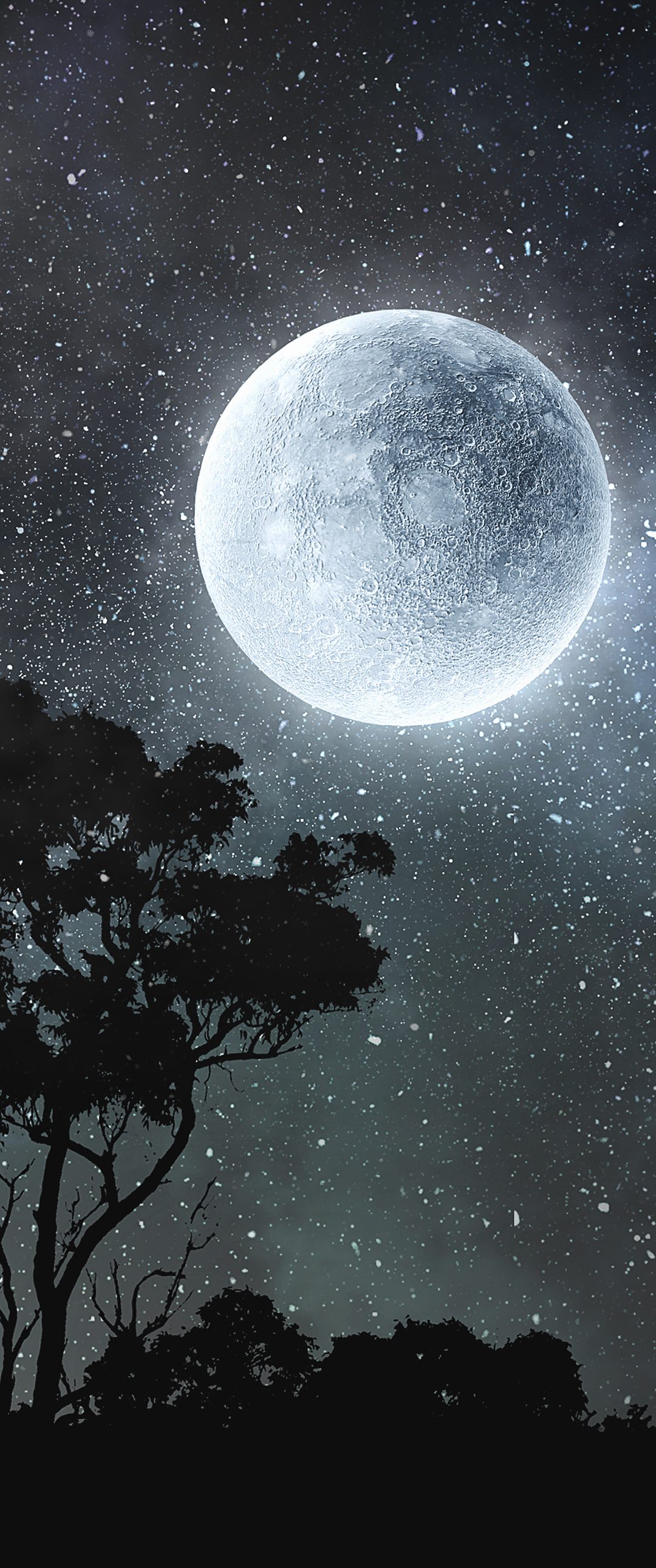
by Somya Devi | Nov 21, 2018 | Astrology, Conjunctions, Retrograde
Full Moon in Taurus
The Moon is waxing towards its brightest point, to align fully opposite the Sun for a full Moon in Taurus at 9:39 pm PST on Thanksgiving night, Thursday, November 22nd. The Moon will be in its sign of exaltation in early sidereal Taurus, in the Vedic nakshatra of Krittika, opposite the Sun in Scorpio. Mars, Jupiter and a retrograde Mercury all aspect this full Moon, while Venus rules over it in Taurus. With the Moon and the mind happy and grounded in this fertile earth sign, this is truly a fitting time to let the heart settle and give thanks for what is.
Exaltation in Taurus
We began this lunar cycle with the Moon dark and approaching debilitation, on November 7th. The Moon is fully “debilitated” in the third degree of Scorpio (although Sun & Moon conjoined to begin this cycle near the end of Libra). In the passionate water sign of Scorpio, the mind becomes aware of its most sensitive points, and can go through turbulent emotions as it rides the waves under Mars’ rulership.
Moon is considered “exalted” in the opposite sign of Taurus, where we find this week’s full Moon. Taurus is an earth sign ruled by Venus. The earth element helps our minds and hearts to find more stability and become grounded, and our emotions are less likely to be tossed about by external forces. Taurus is ruled by Venus, the planet that ultimately helps us to find ways to be happy, so there is a natural inclination towards seeing the beauty and harmony of life when the Moon is here.
Venus is still transiting his own sign of Libra, and getting gradually stronger as he picks up speed after six weeks in retrograde motion. (Though feminine in nature, Venus, like all planets in Jyotish, gains a masculine pronoun when personified.) Venus helps the mind to be happy when the Moon is under his rule, because Venus drives us towards pleasure and happiness, and helps us to look for and see beauty. This is a great outlook for approaching the Thanksgiving holiday, especially when difficult family dynamics may be present. On this holiday where there is a tendency to overindulge in consumable pleasures, however, be especially mindful this year, as Venus (and Jupiter) could help to push that to extremes.
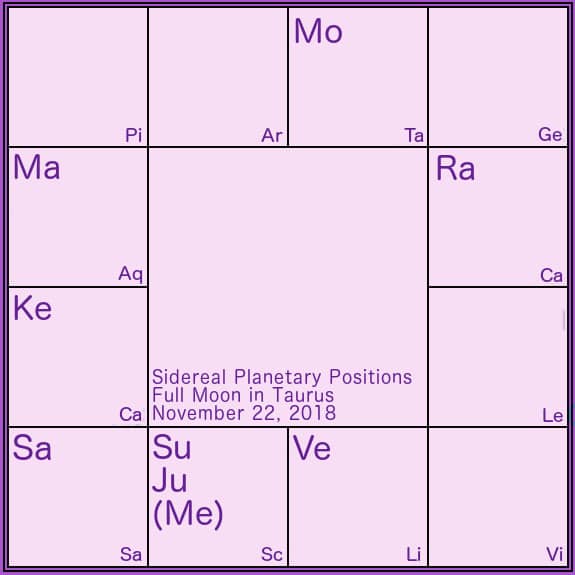
Krittika Nakshatra
Within the Vedic system, Krittika nakshatra spans from 26°40′ Aries to 10° Taurus. This star-sign is known as “the cutter” and is represented by an axe, a razor blade, or a flame. Agni, the Lord of Fire, rules here, and his sharp and transforming nature drive the energy of this nakshatra. Though we are experiencing the beauty-seeking nature of Venus, we are also receiving the purifying and sattvic influence of the Sun, who rules this nakshatra, while the Moon transits here.
This nakshatra can be located in the sky as the cluster of seven stars also known as the Pleiades. In Vedic mythology, these correlate with the wives of the seven sages who found and nursed the baby Kartikeya, the son that Shiva and Parvati birthed through the vehicle of the river Ganga. There is a maternal and nurturing quality to this star, in addition to its power to help us to cut through the unnecessary in our processes of purification. Fittingly, the Indian saint “Amma” (Amritanandamayi) was born under Krittika nakshatra, and demonstrates these qualities of being a nurturing mother to all as well as a powerful sattvic purifier.
Aspects: Mars, Jupiter & Retrograde Mercury
In addition to full illumination from the Sun, this full Moon is also receiving light and energy from Mars, Jupiter, and Mercury (though Jupiter is quite combust, within three degrees of the Sun). Mars’ influence can stimulate the mind into a more rajasic state, and can add a bit of heat and tension. With Mercury also in retrograde motion, be very aware around getting into arguments or trying to explain (or re-explain) your point of view to others. Though Jupiter sends some benefic and inspiring influence, the loftiness of your ideas may be burned up and lost as you attempt to communicate from a philosophical or idealistic place. Mercury will continue in retrograde motion through the next New Moon, on December 6th.

by Somya Devi | Feb 12, 2018 | Astrology, Conjunctions, Eclipses, Holy Days
The planetary energy is all focused around Aquarius right now, as Sun and Moon join both Venus and Mercury there on Wednesday night, a dark Moon night that will bring in a new lunar cycle as well as a partial solar eclipse. The three outer planets, Mars, Jupiter, and Saturn, all cast their gazes on this eclipse through their respective aspects onto Aquarius. The nodes, Rahu and Ketu, influence this New Moon via their eclipsing affect (though they are still transiting the Cancer-Capricorn axis).
The exact time of the New Moon in Aquarius will be at 1:05 pm PST, on Thursday, February 15th. The Moon and Sun will converge in Dhanishta nakshatra at this time, which is the sign of “the wealthy,” showing us our potential to thrive in life, and also associated with music and the steady beat of the cosmic drum. A partial solar eclipse occurs simultaneously, though mostly visible only from Antarctica, from 10:55 am to 2:47 pm PST (18:55 to 22:47 UT), peaking at 12:51 pm PST (20:51 UT).

Aquarius Cycle
With so much energy converging around Aquarius, this eclipse and the coming month will draw our focus towards something larger than ourselves—the greater good, and our potential to create thriving communities around us. Aquarius is ruled by the planet Saturn, who makes us think about the long-term, the bigger picture, and the commitments and hard work that are needed to take us to our goals. As the active, yang, or masculine expression of Saturn, Aquarius is where we are willing to move our efforts outwards, towards long-term goals that affect the world around us. Under an Aquarian mindset we become willing to work for social equality, planetary and even universal harmony. Community values become more important than the individual, and we find ourselves happy to become part of and of service to a greater cause.
Dhanishta
Under Dhanishta nakshatra, the Vedic constellation within Aquarius where this New Moon occurs, we strive to step into beat with the cosmic rhythm. The symbol for this nakshatra, “the wealthiest,” is the drum, often associated with the damaru (hand-drum) of Nataraj, Shiva in the form of the cosmic dancer. There is a universal rhythm that plays through, behind, and around our existence, that goes beyond our individual desire to forge our own path and dance to the beat of our own drum, as they say. When we desire to come into alignment with the cosmic rhythm, and surrender to the greater divine pulse that calls from within, we may actually find ourselves happier than when we were attempting to harness power through a more narrow vision.
Five Planets Influencing
With Venus and Mercury joining in Aquarius, our desires and intellect may also more easily align with this broader vision. Mars, Jupiter, and Saturn are also all casting their drishti (“glance,” or aspect) on Aquarius, and the Sun, Moon, Mercury and Venus. This is due to the special aspects that these planets cast according to Jyotish, different from those in Western astrology. Saturn aspects the third house from himself (and the tenth), Mars the fourth (and the eighth), and Jupiter the fifth (and the ninth). With their influence, our actions, principles, and committed nature are also all aimed at the Aquarian concepts of universal duty, connection, and service.
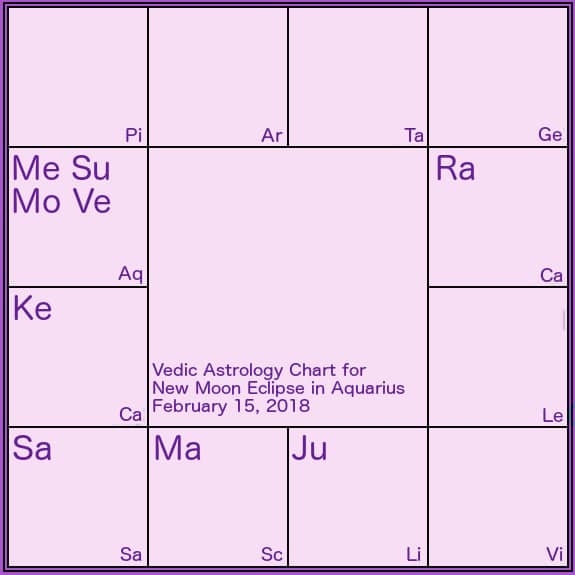
Eclipse
Although the nodes are aligned with Cancer and Capricorn, and this New Moon occurs in Aquarius, Ketu is close enough to the Sun and Moon now that it will cause a partial solar eclipse on Thursday. Although this eclipse may not seem as dramatic as the recent ones that were visible in their totality, it will nevertheless stir the shadow energy of the nodes, and compel us to do some work on ourselves and our lives, or else feel the disturbing effects that eclipses can bring.
With the Sun being eclipsed in Aquarius and Dhanishta, we may feel extremely cut off from our individual power, which can really highlight our human need for community support, and service. When we realize that “I” the individual is not able to solve all our problems, or that personal gain means little without friends to share it with, our place as part of a larger network begins to seem more important. You may also feel cut off from whatever in life is represented by Aquarius in your individual natal chart (or by any planets there), or may have some difficulty (urging you towards transformation) in that area of life. (Free Eclipse Forecast for those on my free mailing list).
This eclipse may show us where we have been neglecting community engagement, public service, or social networking, and if we aren’t willing to look at that, the lessons of the eclipse could be painful. Whether this is a new realization, or even if social involvement is already a large part of your life, this eclipse could be revelatory and transformational, showing you (and your friends) some innovative ways to take your community vision to the next level.
Maha Shivaratri
Tuesday night, the night before the Dark Moon night, is a prime time to dig deep and lay the groundwork for some deep insights and personal growth following Thursday’s eclipse. Tuesday brings Maha Shivaratri, the “great night of Lord Shiva,” in Hindu tradition. It falls on the 14th phase of the waning Moon this month (check here for your local time), and is perhaps the most auspicious night of the year for doing sadhana (spiritual practice). It is traditional on this night to stay up all night fasting, chanting, praying, and meditating.
This holiday honors Lord Shiva, the great ascetic, and particularly two stories of great sacrifices that were made protect the entire creation. One of these comes from the story of the churning of the milk ocean, which the gods and demons were doing in order to release the nectar of immortality. Before the nectar came up, however, a poison came up first. (This is similar to when we do spiritual practice and begin our path of self-inquiry, and negative tendencies often come to light first, which can be a painful experience. Similarly, during a physical fast or cleanse, toxins can be shaken loose and released first, causing a healing crisis before we continue healing into a freer, happier state of being.) When the poison came up from the milk ocean, Lord Shiva consumed it so that it would not engulf humanity, the first story of great sacrifice. His wife, Parvati, held his throat however, so that he could not ingest it, thus saving him in turn.
 Maha Shivaratri also commemorates the wedding of Shiva and Parvati, which also stemmed from great sacrifice made for the benefit of all humanity. It was said that after his first wife, Sati, perished, Shiva was fully devoted only to his sadhana, meditating for aeons in isolation and renouncing the world. Then the demon Tarakasura began running amock on earth, threatening all of humanity. Brahma fortold that only Shiva’s child could defeat Tarakasura, so the gods devised a plan for Sati to reincarnate as Parvati, and win over her Lord to marriage once again. He was not easily swayed, however, and it was only after Parvati became an ascetic and underwent great penance that he agreed to marry.
Maha Shivaratri also commemorates the wedding of Shiva and Parvati, which also stemmed from great sacrifice made for the benefit of all humanity. It was said that after his first wife, Sati, perished, Shiva was fully devoted only to his sadhana, meditating for aeons in isolation and renouncing the world. Then the demon Tarakasura began running amock on earth, threatening all of humanity. Brahma fortold that only Shiva’s child could defeat Tarakasura, so the gods devised a plan for Sati to reincarnate as Parvati, and win over her Lord to marriage once again. He was not easily swayed, however, and it was only after Parvati became an ascetic and underwent great penance that he agreed to marry.
Thus, this holiday is celebrated through the penance of fasting, forgoing food, water, and sleep, for one night, and simultaneously celebrating the union of Lord Shiva and Parvati, or the masculine and feminine energies of creation, that allows this dance of life to continue. It is an apt time to feel the forces of Aquarius upon us, which compel us to consider our role in society, and in the universe, and what personal sacrifices we can make for the greater good. Even if you’re not able to stay up the whole night, any amount of devotional practice, serviceful sacrifice, or chanting of Om Namah Shivaya on this night can have beneficial affects that are magnified greater than on any other night.
Personal readings and Eclipse readings available here.















